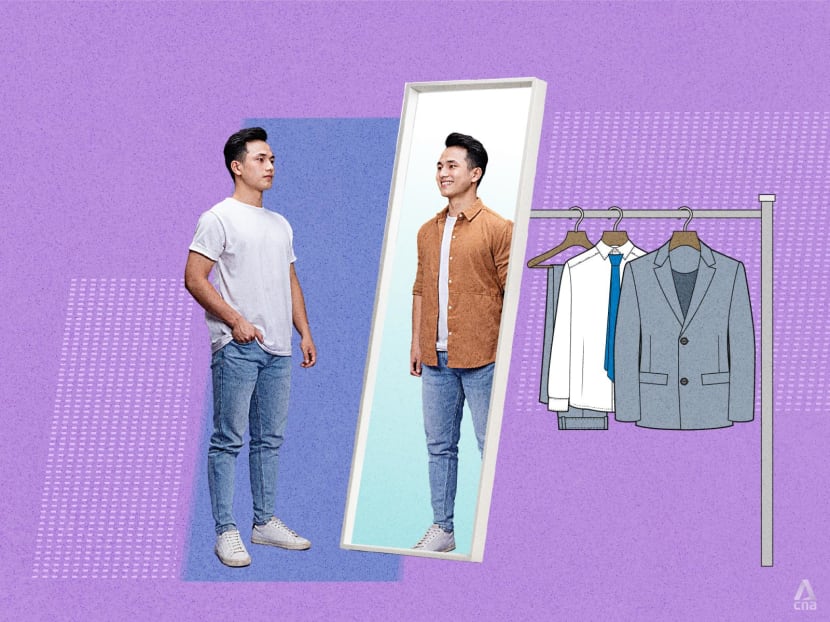Why I forced myself to start wearing nice clothes to the office again
With no clear corporate uniform, we have entered the age of “vibe-based” dressing, a business owner says.

Business owner Kelvin Kao said that whether we like it or not, our attire says something about who we are. (Illustration: CNA/Samuel Woo, iStock)

This audio is generated by an AI tool.
Her question came like a bolt from the blue: “Kelvin, do you really think that shirt is appropriate for a client meeting?”
I looked sheepishly down at my baggy, pre-loved tee – a style that predates our current enlightened era, where oversized second-hand clothes are not only accepted but applauded. On the front of the tee, in bold, bubble-like letters: “Who Farted?”
Suddenly, I realised how out of place I was, standing in the lobby of a glamorous-looking financial centre, surrounded by glamorous-looking people in tailored suits and designer dresses.
“I … uh … I was in a rush. Sorry, boss.”
She sighed, muttered something under her breath, then said: “Why don’t you grab a coffee and wait at the food court? We’ll catch you up after.”
And that, my friends, was how I got red-carded from a meeting for the first – and thankfully last – time.
I deserved it. I had spent three nights working on that deck, only to blow the final five minutes by dressing like a 17-year-old on a break from school. But in that moment, I was indignant. I’d done the work, hadn’t I? Wasn’t that what counted most?
I can’t help but wonder – if that incident were to happen today, in our post-COVID age of “elevated comfort”, would I still be sent away? Or just met with a bemused shrug, before I headed up for the meeting with my colleagues, dressed to the nines in Lululemon athleisure and New Balance sneakers?

THE BYGONE RULES OF WORK WEAR
I’m exaggerating, of course. But then again, just the other day, someone in my own office showed up in slippers. Not slides. Not loafers with irony. Literally, cheap Tat Sing lookalike slippers.
And to her credit, she walked in with the confidence of someone who’d slept eight hours and had eight slides of great ideas.
Honestly, I wasn’t offended. If anything, I was impressed, most because she still managed to look more put-together than I did.
Once upon a time, office fashion had rules. A dress shirt meant effort. A blazer meant intent. A tie meant something big, like a pitch presentation.
No junior executive would be caught dead without patent leather shoes so shiny they could double as mirrors. For women, heels weren’t optional. Everyone was bound by the same unspoken code: dress up to move up.
But somewhere in the midst of the Great Resignation, remote work and that weird season when everyone was baking sourdough in pyjamas, the idea of dressing for work collapsed.
It started with Casual Fridays, rolled on with hybrid Wednesdays and the coffin seemed to be sealed by the silent acceptance of hot pants at team meetings – and I’m not talking about Zoom calls.
NOT JUST WHAT WE WEAR, BUT WHY
Look, I get it. The COVID-19 pandemic rewired everything. We learnt that comfort and productivity weren’t mutually exclusive. You can write strategy decks in a bathing suit as well as you can in a power suit.
But here’s the thing: The erosion of dress codes hasn’t just changed what we wear, it has changed why. It has blurred the signals we once sent without saying a word.
Like it or not, our attire says something about who we are – inside and out.
Take the intern who wears a blazer over a crop top. Or the copywriter in normcore minimalism with an Aesop scent trail. These aren’t just outfits. They’re PowerPoints in cotton. Brand positioning – for people.
With no clear corporate uniform, we’ve entered the age of “vibe-based” dressing.
We no longer dress for the job we want, but for the mood we’re in – “main character energy” now trumps “management-track polish”.
On any given Monday, the odds are pretty much even that someone might show up channelling Kendall Roy from HBO series Succession (often dressed in low-key but still ultra-expensive threads) or Gen Zer Portia from the other HBO show The White Lotus (with her haphazard, out-of-place ensembles).
Instead of official dress codes, we now have aesthetic lanes: “quiet luxury”, “clean girl”, “bloke-core”, “I-don’t-care-but-I-do”.
If the typical office of old looked like a law firm, today’s looks more like a fashion-week reel.
In a way, I’m here for it. But I wonder: Is there still room for dressing to impress?
Not in a Mad Men cosplay way (where the Emmy-winning HBO series showcased fashion in the 1960s), but in a quiet, intentional way.
A crisp shirt, not for the client but for yourself. Trousers with seams, because the day deserves them.
There’s dignity in effort, even in something as trivial as hems.
In a previous job, I had a colleague who wore button-downs every day.
It was not out of vanity (okay, not just out of vanity), but to flip the switch from “home self” to “work self” – like a symbolic and less extreme version of what goes on in Severance (the science-fiction show where employees have a disconnect between their personal and work lives).
And when he walked into a room, you could feel it. Meetings felt sharper. People sat up, not because he commanded authority, but because he carried presence. And it definitely stuck with me.
So a few weeks ago, I did something small.
I pulled out trousers with seams. Picked a shirt with buttons and a collar. Reached past my Homer Simpson “Bush Meme” Stan Smiths and – cautiously – grabbed a pair of real shoes. Proper shoes.
Of course, no one noticed, but that’s the point. It really is about noticing yourself and showing up accordingly.
Showing up with intention isn’t performative. It’s grounding. A way of saying: I’m here. I’m locked in. Let’s go.
Because in this era of anything-goes, effort matters – and intention still makes an impression.













